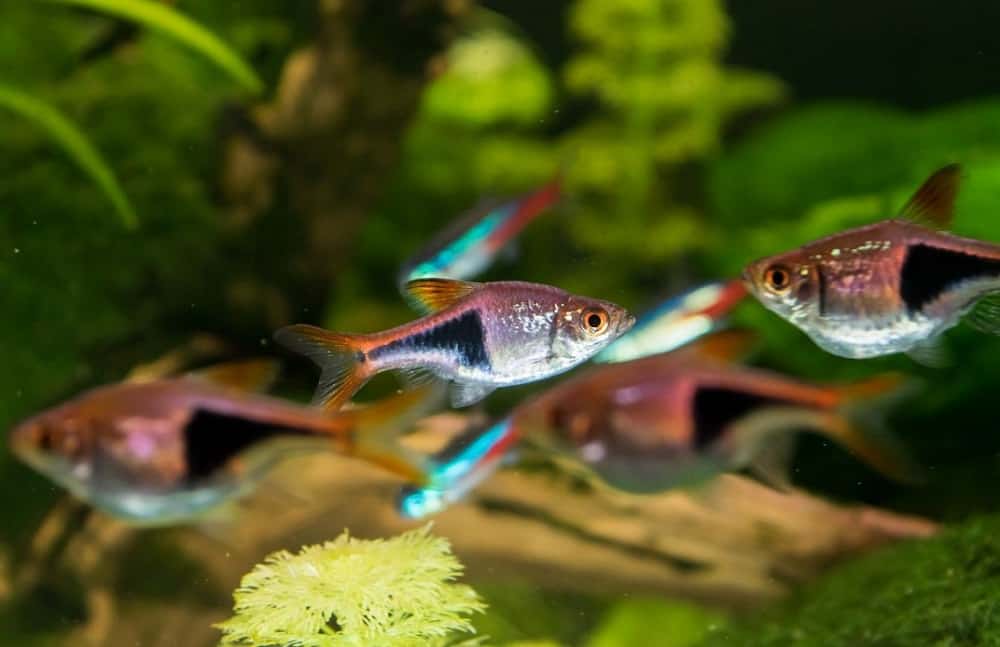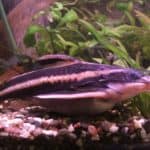There are various types of Rasbora, such as Harlequin, scissortail, Chili, Galaxy and lambchop. Whichever type you choose, these active and robust fish will make an excellent addition to your home aquarium.
They are popular with beginner aquarists because they are confident, fun and considered fairly easy to care for. The only downside is that breeding them in a domestic environment is difficult and unpredictable.

If you are interested in housing Rasboras, or you want to know more about these intriguing little fish, then read on! We have put together lots of interesting information about their appearance, behaviour, tank requirements, diet and more.
Species Summary
Rasboras are peaceful, colorful freshwater fish that like to live in communities in the wild and in a domestic tank. They are found in the gently flowing forest streams of Southeast Asia including China.
They also live in floodplains during the wet season. Their natural habitat is fairly shallow water with plenty of aquatic vegetation.
Care Guide
Tank Size
Most species of Rasbora need a minimum tank size of around 10 gallons and are ideal for small to medium sized aquariums. Some species of Rabora, like the dwarf emerald Rasbora, are even suitable for nano aquariums that can sit on a desktop, as they don’t grow larger than one inch.
Whilst these fish are small, they enjoy swimming as a group so make sure they have space to do this. They also like to be surrounded by plants so make sure you have a tank large enough to provide them with a nice environment to live in.
They get on well with other fish so if you want to have multiple species housed together then ensure you consider this when thinking about the size of your tank.
Whichever species you choose, ensure your tank has a lid as Rasboras of all sizes will jump!
Tank Mates
Rasbora have a naturally peaceful temperament so finding tank mates for them is relatively easy, as long as you don’t house them with any fish that will consider them as a food source.
Try housing them with small tetras, gourami, danios, barbs, guppies and platies. They could also live with small, peaceful bottom-dwellers like certain small species of loach and catfish.
As long as you choose small, peaceful tank mates then you are free to experiment with combinations of fish, as they will likely get on with any species you put them with.
Same Species Tanks
Rasbora live in schools in the wild, and are happiest in a large community. It is recommended to keep them in groups of at least 7, but many aquarists have success with shoals of 10 or more. They can also live with different types and sizes of Rasbora.
If you already have an established aquarium, you should still be able to introduce a school of Rasbora without any issues.
Water Parameters
The temperature of the water should be within 72 and 80 degrees fahrenheit. The PH of the water in their natural habitat can reach levels as low as 4.0, but an ideal PH level for a domestic tank would be between 6.8 and 7.8.
If you are buying Rasbora that have been bred in captivity they will be used to much harder water than their natural habitat, somewhere between 3 and 8 KH. Make sure you check whether your Rasbora are wild-caught or raised commercially before you set the conditions of your tank.
Make sure you have a good quality water filter and perform regular 25% water changes to keep the tank clean and the water unpolluted. The water flow should be fairly gentle to replicate the streams in their natural habitat.
What To Put In Their Tank
In the Rasbora’s natural habitat, the light is often blocked by dense forest above the water and dense plant life below the surface. This means they would prefer more subdued lighting conditions.
A dark sand substrate will best mimic the muddy floors of the streams they are used to, well decorated with rocks. They will be happiest amongst a variety of plant life. They like dense vegetation or plants with broad leaves that are soft and easy to swim through.
If you want to see them explore more of the tank, include some floating vegetation to encourage them to swim in the upper level.
Common Diseases
Rasbora are known for being hardy and not getting sick very often, which makes them very popular with beginner aquarists. However, they are still susceptible to parasites like Ich if their tank is not well maintained. Ich causes white spots on their skin so is easy to spot.
If you suspect that one of your fish has a parasitic infection, remove them from the main tank immediately to prevent it spreading to the other fish. Keep them in a quarantine tank until they are fully recovered. In the meantime, ensure the main tank is clean and the water is changed.
The best way to avoid your fish getting sick is to keep the tank clean and maintain the correct water parameters, make sure they are getting the right nutrients from their diet, and keep their stress levels low. Stress can dramatically reduce the lifespan of a fish by making them weaker and less able to fight off illness and infection.
Food & Diet
Rasboras are micro-predators that feed on small insects, worms and crustaceans. They also eat zooplankton. To ensure they receive all the right nutrients, it is best to feed them on tropical flakes, granules or shrimp pellets.
They also enjoy frozen and live food as a treat, but ensure you consider the size of the Rasbora species and cut up their food small enough to match their mouth size.
Lifespan
The average lifespan of most varieties of Rasbora is around 6 years. This can differ between species, and is dependent on them living in a well-maintained tank with the correct water parameters.
Reducing the stress levels of your fish can also help them to live a long and happy life, which comes down to providing a well decorated tank that mimics the natural environment and a nutrient rich diet.
Appearance
Rasbora are generally small in size with delicate fins which are often translucent. Some species have distinctive forked tails. Their bodies can be rounded or elongated, depending on the species.
Many types of Rasbora have very vibrant coloring, especially the smaller varieties, which range from pink, orange, green, and purple. Their colors will become more vibrant if they are happy, healthy and surrounded by lots of plants.
Size
The size of these fish varies between species. Most species of Rasbora grow to less than 4 inches long. There are certain varieties that grow no bigger than one inch long.
Behaviour & Temperament
Rasbora are peaceful but not particularly shy, making them very popular with both beginner and experienced aquarists as they are a welcome addition to many home aquariums. They are confident and spend a lot of time swimming. They will not spend much time at the bottom of the tank.
It is very unusual to see Rasbora displaying any kind of aggressive behavior towards other fish. But they can be the victims of it due to their size and placid nature.
They like to swim as a group which is wonderful to watch, especially if you have a colorful species of Rasbora.
Breeding
Breeding Rasboras in a domestic tank is notoriously difficult. In the wild, they provide little to no parental care, and scatter their eggs amongst the abundant plant life.
They even lay their eggs on the underside of leaves. It is down to chance as to whether your Rasboras will produce young. If they feel the conditions are right they will spawn with no involvement from their aquarist.
If you are very keen to breed your Rasbora then switching to a diet of live food can sometimes encourage the spawning process.
Gender Differences: Male vs Female
Differences between male and female Rasbora depend on the species- the males will usually have slightly darker or more prominent markings and more color on their fins. They are usually around the same size, but females will often have a slightly rounder body.
Fun Facts
- Rasboras have been nicknamed ‘The Spartacus Fish’.
- The water in the Rasbora’s natural habitat is often dark in colour, but it’s not dirty. The brown color is caused by abundant organic matter in the water.








